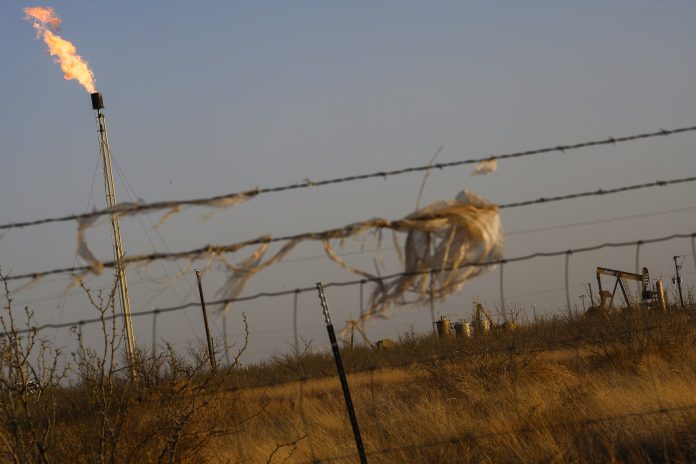
New natural gas drilling hasn’t totally cratered in spite of stubbornly low prices, but it has been seriously dented as many producers pull back and wait for conditions to improve.
Permian Basin Petroleum Association Executive Vice President Stephen Robertson, Texas Oil & Gas Association President Todd Staples, Texas Independent Producers & Royalty Owners President Ed Longanecker and Panhandle Producers & Royalty Owners President Judy Stark cite a high volume of gas being put in storage and other factors.
The price per thousand cubic feet fell from $9.85 last August to $3.46 in November and $2.377 Wednesday, having stayed just over $2 since the first of the year.
Robertson said Wednesday that there “is not much drilling specifically for natural gas in the Permian Basin.
“Largely, the natural gas produced from our region comes as associated gas due to oil well drilling,” he said. “Overall in the United States, we have read that natural gas production has slowed down, mostly due to insufficient demand growth and inadequate midstream infrastructure.
“Even with the Permian Basin being largely an oil play that produces associated gas, inadequate midstream infrastructure has definitely curtailed production of both oil and natural gas in the region at different times in its history but especially during the cycle that some call the shale boom that we have experienced over the last decade-plus.”
Robertson said the completion of the several liquefied natural gas export terminals that are under construction would help.
“We could see demand for natural gas grow as the export market has been the primary source of demand growth in the last few years,” he said. “However, without the pipeline infrastructure to get natural gas from the Permian Basin to those terminals, the positives of this growth in demand might not be realized by operators in our region.
“Fortunately, pipeline projects are also reported to be in the works to help alleviate these constraints as well.” Robertson said.
Staples said gas drilling “has held up well despite recent low prices and it has consistently shown an ability to respond quickly to changes in market conditions.
“Gas production has remained strong and above 100 billion cubic feet per day, according to the U.S. Energy Information Administration, despite working gas in storage being near the top of its five-year range, relatively mild seasonal weather and some localized infrastructure issues that have impacted regional production,” he said.
Staples said the combination of a strong supply with the other factors “has naturally corresponded with lower U.S. natural gas drilling.”
Citing a Baker Hughes Corp. report, Staples said, “Over the past three months drilling fell by 10 rigs or 6.6 percent.
“Compared with U.S. gas drilling changes over all three-month periods since 1987, however, the recent drop is typical and ranks near the 40th percentile.
“Thanks to the American energy revolution, the gas market can respond quickly and efficiently to market conditions including a strong positive response last fall. Today and for the foreseeable future, this benefits consumers in Texas and nationwide.”
Longanecker said the Permian Basin “has been projected to have a record-breaking year in oil production once again and those figures are not set to slow despite short-term market turbulence.
“A myriad of factors including the expansion of liquefied natural gas export facilities and steady oil demand has led to an unusual surplus of natural gas on the global market,” Longanecker said. “Producers, especially Texas producers, are focused on the long-term trend of increasing demand for both oil and natural gas.”
He noted that the EIA in January projected that crude oil production in the Basin would increase by 470,000 barrels per day to average 5.7 million b/d this year.
“As the year has progressed, we’ve seen Permian oil production steadily rise and as that has risen so has associated gas production,” Longanecker said. “Associated gas has become an increasingly large portion of natural gas production and the EIA predicts that by 2025 associated gas will make up 30 percent of all natural gas produced.”
“Thanks to milder winter weather, U.S. natural gas inventories are unusually high,” the TIPRO leader said. “As of April, they stood 19 percent above the previous five-year average.”
Stark said supply and demand “are always the issue.
“This past winter season nationwide was unusually warm, which lowered the demand for heating and left gas storage inventories higher,” Stark said from Amarillo. “The market projects an average price of $2.35, but it could reach $3 this summer during peak demand.
“Other factors include natural gas contracts, which can run lower than spot prices, along with high LNG exports and low domestic consumption.
“At present I can’t imagine any company drilling gas wells at these and projected prices going into 2024.”
Stark said the Biden administration’s attempt “to kill all fossil fuels will eventually cause both commercially and utility based prices for products like propane to go higher as supplies deplete.
“If they’re successful, killing these energy sources and opting for higher priced, unreliable solar and wind will drive prices up excessively for consumers,” she said.



